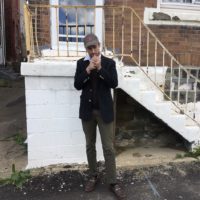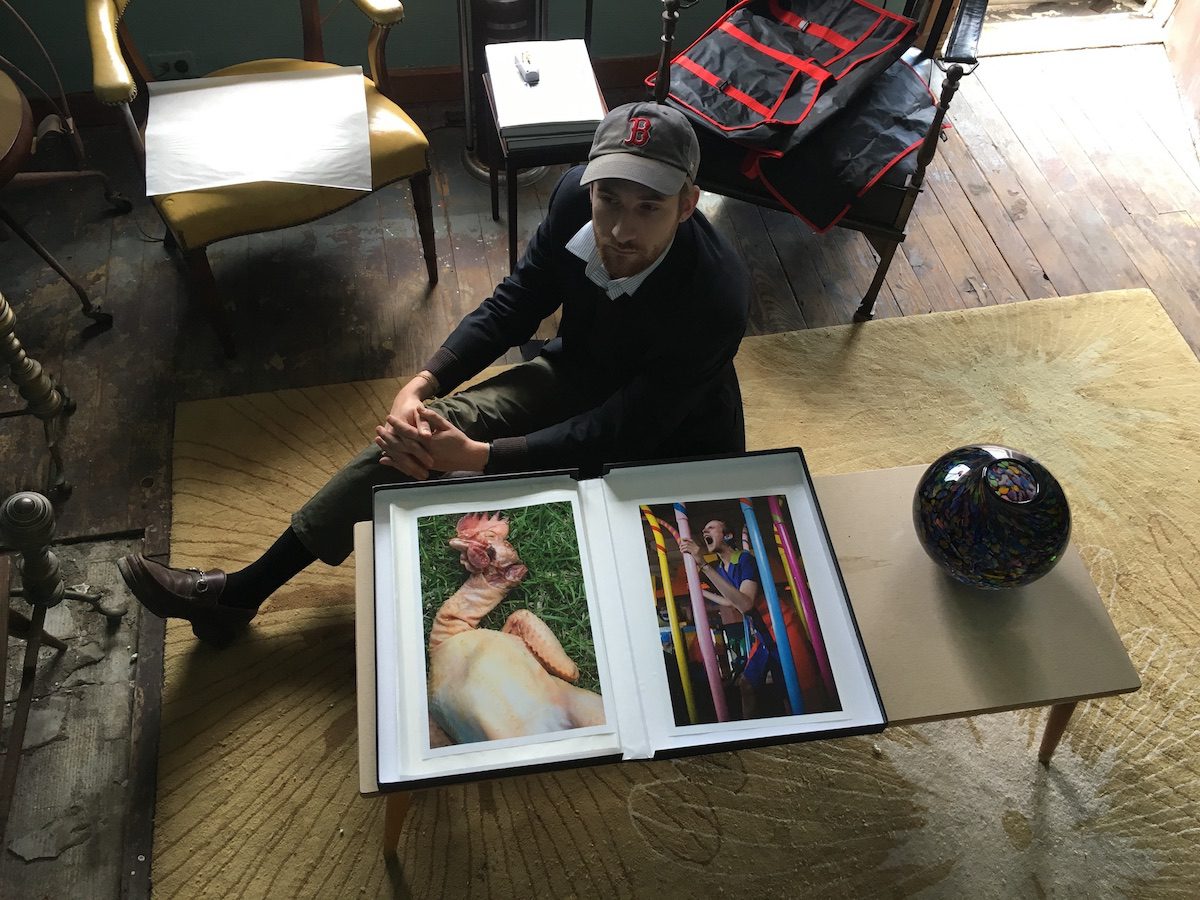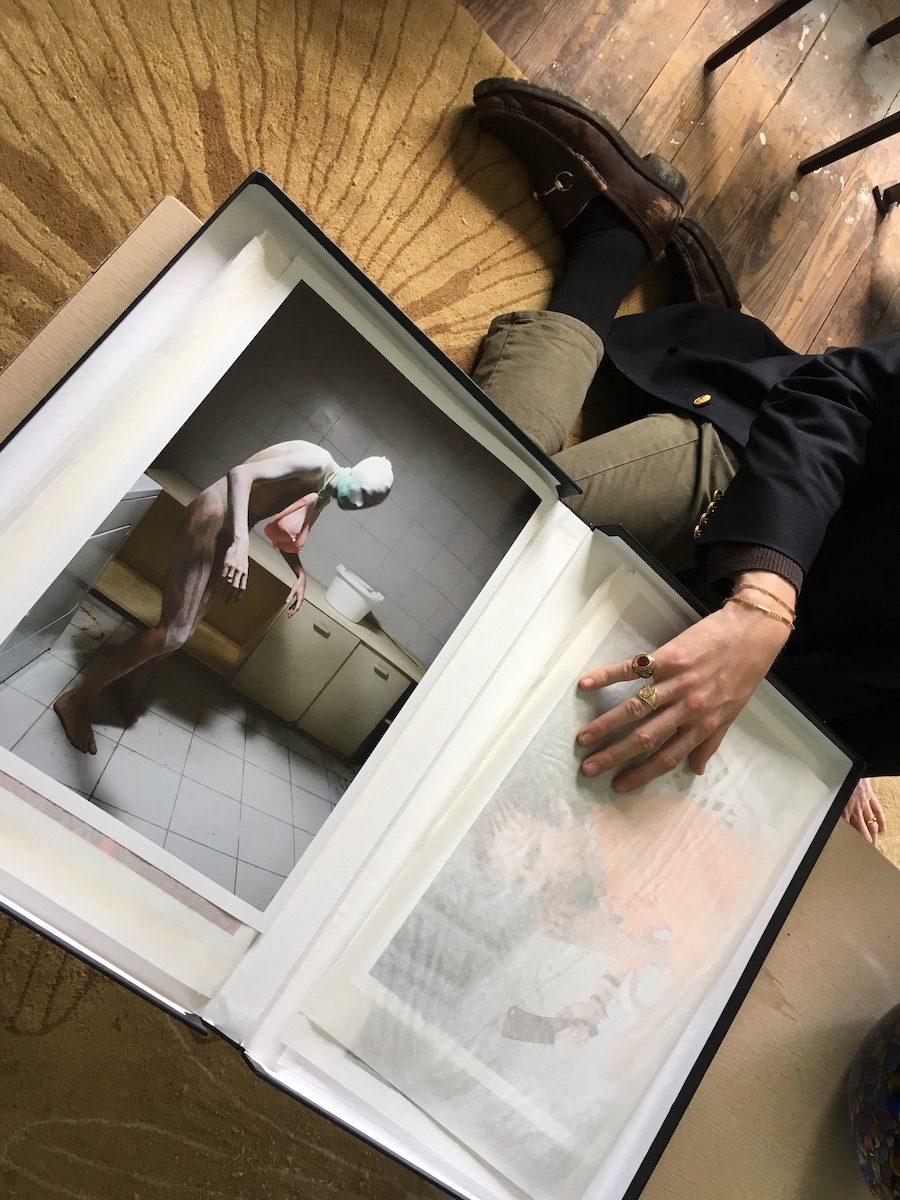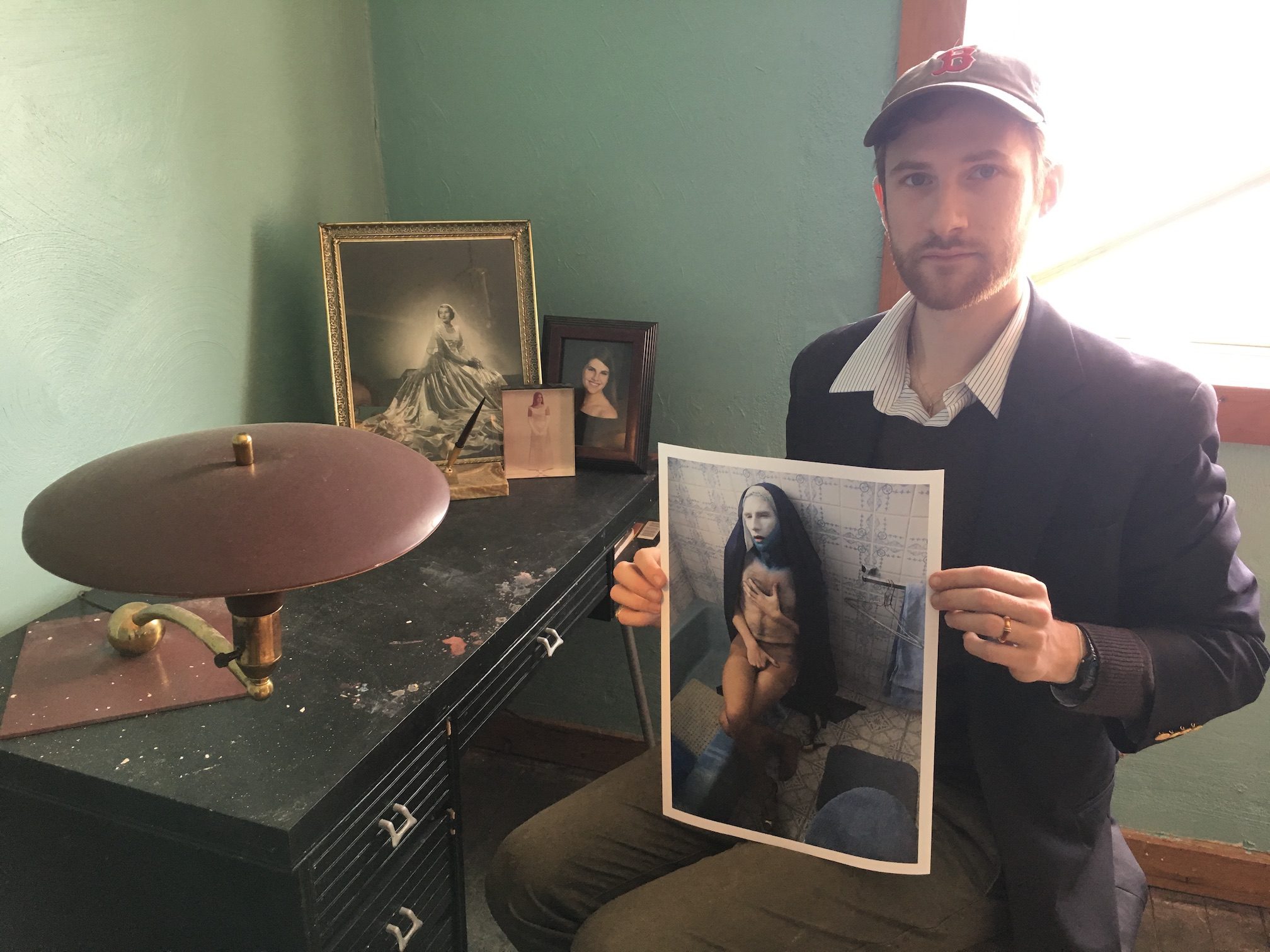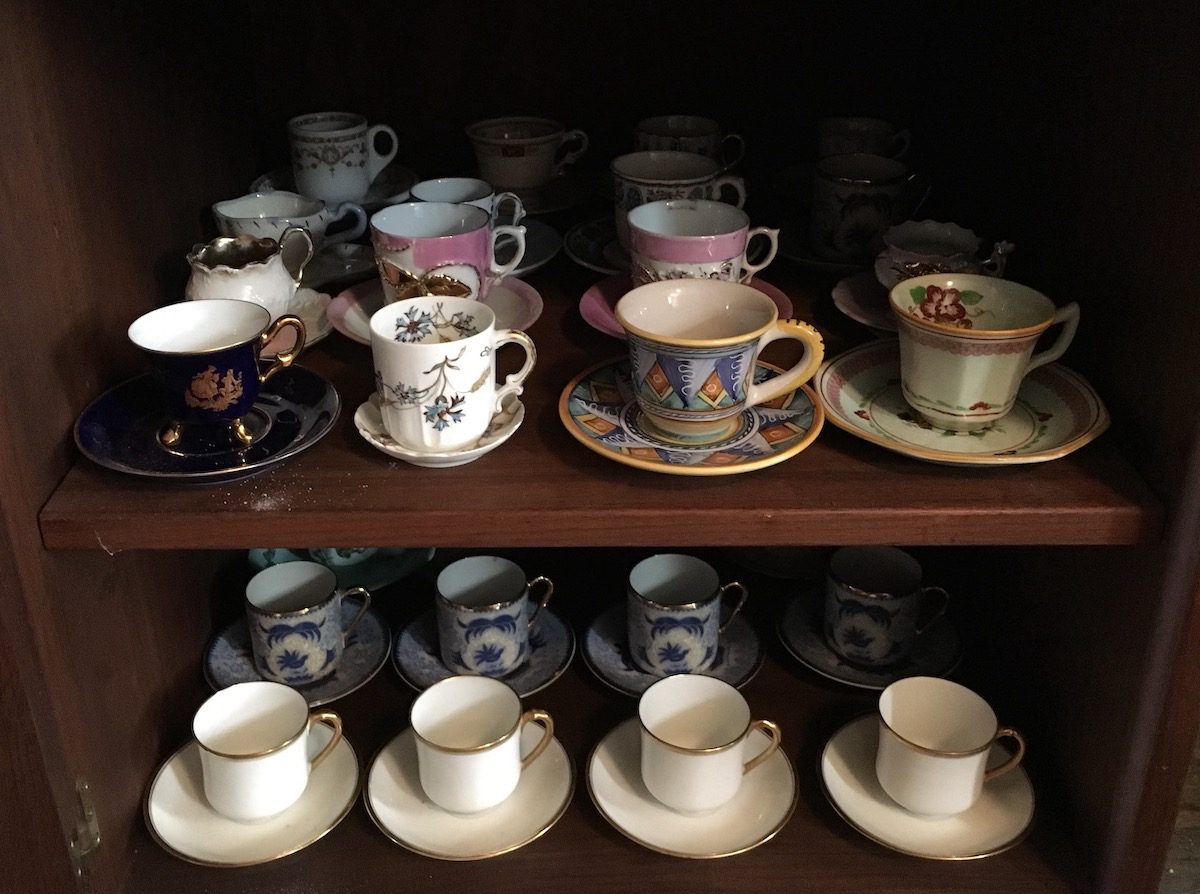Artist Sam Brown opens a wooden cabinet in his “queer home” in Pittsburgh’s Garfield neighborhood to expose two shelves full of miniature porcelain tea sets. “Tiny Tea,” he calls it. I choose the one named Ann. Ann, or “Granny Annie,” as Brown calls her, was the name of Brown’s paternal grandmother, a former supermodel.
Brown is sitting across from me, smoking and sipping from Stuart, named after Ann’s husband, Brown’s grandfather. Brown is a family man. He has a nickname for everyone: His sister Hilary is “Bun,” his maternal grandmother Mary both “Polly” and “Gangy,” (from Arrested Development), his aunt—which he pronounces “awnt”—Marguerite is “Moc.” Brown’s connection to his family makes him appear wholesome. But don’t be fooled: This man is queer.
In 2014, Brown and his friend, an artist known as Astro, met up in Ecuador for a project they’d been brainstorming for years: TRANS.MEAT. In it, Brown dressed in drag while Astro photographed him in colorful scenes blending Ecuadorian politics and tradition. The project was an exploration of femininity and the various archetypes of womanhood, specific to Ecuador.
The trans movement was just beginning at this time, and Brown and Astro were earning a name for themselves. But the pace of their growing fame proved to be too much, too fast. Brown’s relationship with Astro began to suffer; his mental health did, too. He shaved his eyebrows off and started hearing voices. It wasn’t long until he flew back to Pittsburgh to recoup.
In our interview, Brown and I discuss what big dreams that are realized can mean for artists—including the highs, the lows, and the sometimes messy aftermath.
***
The Rumpus: I wanted to talk about your project, TRANS.MEAT. You gained a following from that project.
Sam Brown: Yeah. There was quite a bit of press that happened due to it. My best friend from my undergraduate, Astro, they are Ecuadorian. They are from the capital, Quito. Astro and I would have tea often as undergrads and talk about art and talk about life. We were so young, being like, “We’re going to change the world with our art…” We both ran around in our mid-twenties working and doing things. I was traveling, they were working at their family’s hat making business in Ecuador. They were making traditional Ecuadorian Panama hats, which are originally made in Ecuador, not in Panama.
In January of 2014, we both quit our jobs and I hopped on a plane and went to Ecuador. I was starting to do drag and Astro was interested in giving voice to the feminine voices—women’s voices—in Ecuador.
We were there for a couple of months taking a psychology course and talking about something that’s called “the lost object.” It’s something that you lost, that you no longer have, that creates a gut reaction. It creates conflict. The way we decided to deal with that is by using bits of meat that we would get at marketplaces.
How the first episode of TRANS.MEAT transpired is… I found this great orange sherbet-colored skirt suit and I brought it home to Astro. They were like, “Ah, man, that’s great. You know what that would look great with? A dead chicken.” [Laughs]
Rumpus: [Laughs]
Brown: I was just scouting around our neighborhood and found this beautiful house that was owned by an old woman. It had this 1970s chimney that protruded and was avocado-colored. I was like, “Oh, that avocado against that sherbet orange skirt suit would be great.” So, we just knocked on the woman’s door and Astro said, “Hello. We are artists. This guy’s from The States. We want to photograph in your garden,” and she was like, “Okay, sure.” So we went maybe a week later and got a dead hen—a whole hen with like, the head—and we did a photo shoot. We went back and looked at the photos and were like, “Well, this is interesting.” It created a reaction.
The next one we did was Che Guevara, only in drag. We went to one old man and I was dressed up in heels and sparkly, sequined tights and Astro was like, “Who do you think this guy reminds you of?” He was like, “I don’t know.” They were like, “It’s Che Guevara,” and he’s like, “No, this is all wrong. You have to be masculine, you have to have a beard, you have to have strength, and this guy is a pansy.”
We started to unpack that we were looking at different archetypes of women. There’s the revolutionary woman, there’s the mother, there’s the office worker. We interviewed women who experienced those archetypes, who lived parts of their lives embodying that archetype. We would record these women’s stories, write them down, and consider them as we went to do performances. Through our interactions, we ended up stumbling onto the transgender communities. We found two groups of women who were the hair salon girls and the sex workers. In Ecuador, that’s what the lifestyle of being a trans woman is. That’s the work you can get: one or the other. Maybe selling fruit in the street at the market, too.
The experience of trans women is very visible to the people in Ecuador. The sex workers are always in the same space, in the same part of town. I remember reading in a government book which spaces are designated to whom. It said that the transgender prostitutes work in the block by the national theater, and they also work at a train station to the north called La Y. Their sex sells. People patronize them and they make a living. We got to know one woman fairly well. Her name is La China. She has a Chinese face and that’s what she goes by. She was kicked out of her house when she was eight for being kind of femme and she had to go work—beg—in the streets. She found that if she presented as a woman, she was able to get more work, more clients, and more money, and to navigate life more easily. She also found a community in the streets. Now she’s what was called the “Dueña de la Plaza.” She’s like the owner of The Plaza. She’s like the head bitch of both the place in the center of town and up at La Y.
In the center of town, she was very magnanimous and took care of her babies and made sure everyone was just so. But if she was up in the north, she’d be like, “Give me your blouse. I like your blouse. Give it to me.” She was a tough bitch. She was like, “I’ve cracked skulls before.” Astro went with China to her home and China showed her how she prepares for the day to go out working. She puts on twelve layers of nylons to form her body and thin layers of foam at the hips to build out a woman’s ass. She’d have clients who were like, “Hey, we want to have unprotected sex,” and when they’d get back to the room, she said this statement: “Honey, I don’t know you, you don’t know me. You have a family. Let’s just play it safe.” That’s how she would keep things safe.
Rumpus: How was TRANS.MEAT received?
Brown: The trans community was really pleased. The drag community was pleased. The academic community was pleased. We were hosted at the University de la FLACSO, which is a university of sociology and social sciences. There was an international conference of sociology. People from all over Latin America came to Quito to have a conference and our project TRANS.MEAT was in the gallery there, which is the premiere contemporary art gallery in that city. Everywhere that we went during this time period, everyone was just so excited.
When we made this project, it was before Caitlyn Jenner had come out. The trans movement had just started. There was a graduate student at the University of Nottingham in the UK who wrote a paper about our work. We were interviewed by Ecuadorian NPR. We got an invitation to exhibit in Amsterdam. We ended up being exhibited at the Museum of Contemporary Art in the center of town in this beautiful colonial building. It used to be a military hospital and it had archways and a grand staircase. We were in the main hall, with the staircase. We smattered the photographs along this giant wall and we did a performance where Astro took a liver and painted the walls with the liver while I whipped myself with cables.
It was all very exciting, but we had to take a break because it was just too much. It was putting a lot of stress on our relationship—Astro’s and my relationship—because there was so much work and a lot of pressure.
Rumpus: You weren’t even in school anymore.
Brown: No, we just did this. We got a grant to print the images, but we funded the original project out of our own pockets. The photographs were like six feet tall and the gallery was like four times the size of this house. We could ride our bikes around it.
Rumpus: Now that you’ve had so much success, how do you reckon with the seemingly mundane nature of everyday life again?
Brown: Last year I was having a hard time with it. I was like, How do I do the next big thing? I was having flights of fancy and doing all kinds of weird stuff, but that weird stuff got into a group show into East London. I got to go to East London and exhibit a photograph I took in 2010. It was a selfie mirroring Venus of Urbino and celebrating fifty years of decriminalization of sodomy in England.
Then I came back and was like, I’m exhausted. I need to just chill out and do nothing exciting. So, I’m just really thrilled to just smoke and drink tea. People ask me out on dates, so I just go out on dates when people ask me out on a date. Everything’s really pleasant.
The whole time that I was doing all of these projects and all of these things, I was… overworked and stressed and concerned. Now I’m just kicking it here, being like, Well, maybe I could finagle some way to buy this house. I want to turn the field out back into a cherry orchard. I have long-term plans with this property: to have a cherry orchard and live in a cherry field. [Laughs]
Rumpus: Switching gears a little bit, my other question for you was about calling yourself a “self-expressionist.”
Brown: Well, that’s what we were working on at the time. The teens were about, This is how I am, this is how I identify myself, this is how I visualize myself, this is who I am. My roommate changed her computer to automatically write, instead of millennial—I hate that word—“snakepeople.” [Laughs]
Snakepeople are just trying to find their way in a postmodern world. I don’t know what everything means anymore, because we have all of these objects from across time that are all converging at the same moment. It’s all about choice—personal choice—and creating identity through personal choice.
Rumpus: Would you consider self-expression to be a form of art all on its own?
Brown: Oh definitely, yeah. Anything that’s curated: A curated look, a curated makeup palette, a curated collection of dishware. If it has intention; it has purpose. I’ve always held that the message of the art is withdrawn from the audience. I’m the image maker. I’m the one that draws the disparate parts together, and then you as the viewer come away like, Oh, this relates to myself for these reasons. There’s a mixture of feeling that comes from mixing bits and pieces together. That’s what self-expressionism is.
Rumpus: But you wouldn’t necessarily identify yourself as a self-expressionist in your art now?
Brown: I’m in a transition period. I’m transitioning from my twenties into my thirties. I was all hopped up on trying to get famous and being known and making it and being the “next biggest thing.” Now I’m thinking: Okay, I’ve achieved a lot. How can I live calmly and reasonably and still have a practice of making things?
For a period of time in the end of 2017, I was taking pictures of the blank corners of rooms. I was tired of photographing things and people. I found it to be divisive to be taking imagery of someone else’s work. It’s like if I were to take a picture of that chair and frame it and put it in a gallery. That’s someone else’s chair that they designed.
For a period of time, I was like, “I’ll document what nothing is.” Then I found God in the corners. In a space where there was emptiness, there was a lot of breathing room. Compositionally in the image, there were a lot of things going on like line and texture and shadow and light. Even in spaces that I was demarcating as void, there was a lot of information. I’m trying to create as much empty, void space in materialism as possible.
Rumpus: Who or what are your influences?
Brown: My family. My dad is a painter. He paints little lead soldiers and has the mind of an artist. My mother is a horticulturist. My [maternal] grandmother was a creative writer, a classical singer, and a Southern hostess. The grandmother who was a model had this funky, fun house. It was leopard-print, wall-to-wall carpeting everywhere.
Rumpus: You said she was on the cover of LIFE magazine?
Brown: Yeah, 1949.
Rumpus: Did she live in New York?
Brown: She grew up in New York in a hotel in Astoria. She lived a very fabulous lifestyle. She lived in Barbados for a while with my dad and aunt. The Chalfant family, who are from Pittsburgh but moved to New York pretty early, they’re in their seventies now. Henry Chalfant documented subway train graffiti in 1980. His photographs are like a historical document of early graffiti art. His wife, Kathleen Chalfant, she’s a very good stage actress who was in the original production of Angels in America. She played the angel: Meryl Streep’s character.
My grandfather was a mentor for Henry. My granddad died before I was born. I was named after him and I showed a lot of potential in the arts early on. I always had Christmas dinner with these people. From age seven to eighteen, my school-boy hobby was to be in musicals and plays. They would come see my acting shows over the summer. They encouraged me, took me to shows in New York and opened up their home to me whenever I came through. Henry turned out to be a closer mentor figure because he had more time on his hands. I was really inspired by them and seeing how they reached quite a bit of fame, so I modeled myself after how they worked.
Rumpus: What’s next for you? What are you working on now?
Brown: Right now, I am in art therapy. I’ve been working on organizing my house… Clean house, clean mind, clean bag, clean drawers. I’m organizing everything using the East Asian techniques of The Life-Changing Magic of Tidying Up and feng shui. When you intentionally create a vacuum by getting rid of things that don’t bring in happiness, it allows space for new and positive energy—for God energy—to flow in.
I rent this house. It’s been working as an artist residency. I’ve had probably about a half dozen different artists come through and live here and do their work. We drink Tiny Tea and sit in the Colonial Room and have a nice time. We look at the art. We don’t really watch TV, we just sit and communicate and listen to old tapes and old records.
Rumpus: What kinds of things are in the room that make it the Colonial Room?
Brown: Vintage animal print pillows from my grandma, the model; a straw hat; a zebra rug; English hunting china.
Rumpus: What is hunting china?
Brown: [It] was from my great grandmother and my grandmother. My dad’s dad family—the man that [Ann] married and had my dad with—was a Jones, of an old steel company that was here [in Pittsburgh] called J&L Steel. I have little bits and pieces of J&L memorabilia.
If you go to the Carnegie International in the furniture and design room, there’s a portrait of George Washington that was my great grandmother’s. It was a gift from one of the Joneses. That stuff is silly. It’s kind of fancy in this town, but in comparison to France or something like that, it’s just like, “Oh yeah, this is the silly thing that I come from.”
***
Interviewer’s note: Brown’s father died in March of 2019. When I talk to him a few weeks later, he says he’s been in mourning. He switched the lease of his home to a friend, and is now owns the house next door to it. He’s still in art therapy, and is focusing on therapeutic finger painting. He makes “scratch-gestures” of spinal columns, and says he feels it’s a metaphor for the “way of the warrior.” According to Brown, it’s a way to experience and verbalize unconscious feelings and emotions. “I don’t even know what I’m saying when I’m painting, I’m just talking,” he says. He’s now “graduated” to moderate-size tea due to essential tremor. “I never made a cherry orchard,” he says, “But maybe I’ll have apples.”
***
Photographs by Ash Green. Original photographs appearing within photographs of Sam Brown by Astro.
